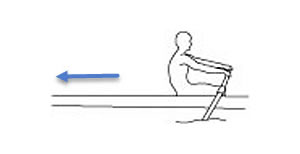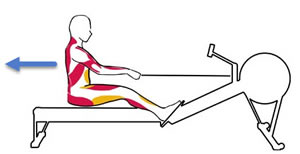Slip Slidin’ Away
I’ve been using my indoor rower on a (smooth surface) floor and it moves back and forth while I row. I was surprised by that. Do I need a mat or other surface for my indoor rower?
The Concept2 Indoor Rower has rubber caps on the feet to help keep it from slipping, but some athletes may experience movement from the Model D or Model E while in use. This movement can be caused by very high stroke ratings and fast rowing; but excessive movement, during ordinary use, signifies a possible technique error.

Boat movement
While in a rowing shell, the movement of the athlete is “backwards.” The bow of the boat is to the back of the athlete. The athlete must look over her shoulder to see the direction of travel.

Indoor rower direction of work
On the indoor rower, the work portion of the stroke (the "drive") is in a similar direction: away from the flywheel.
In a boat, any excessive or rough movement back up the slide (the “recovery”) in preparation for the next stroke can cause the boat to physically buck in the direction of the stern. Rowers call this “check.” Sometimes, this movement is subtle and difficult to perceive. In extreme cases, the boat practically comes to a stop on every stroke.
The same phenomenon can happen on the indoor rower. If your indoor rower slips on a smooth flooring service in the direction of the flywheel, you are likely “checking the boat.” This means that you should slow down the recovery so that it is controlled. You should not be engaging your hamstrings or foot straps to speed up the slide. A good drill to practice is rowing without foot straps as described in our The Necessity of Foot Straps discussion.
If you are using your feet to pull up on the recovery, you are most likely “rushing the slide” (see our Technique Video, starting at minute 4:52). The legs drills in our Common Errors video (minute 7:07) can also help you to achieve the proper rowing ratio, which will slow down your recovery in relation to the drive. A patient recovery can lead to a faster drive.
As shown in our Common Errors video, lunging at the catch (minute 2:26) can also move too much bodyweight in the direction of the flywheel.
As you increase the intensity of your rowing, we recommend reviewing our Rowing with Greater Intensity video. Proper technique will benefit your speed at high stroke ratings and fast paces.
Ideally, any movement of the indoor rower on a slippery service is in the direction of the drive. If this movement becomes a concern on your flooring, you can consider purchasing an indoor rower floor mat, use weights on the legs, or change where you use the machine so that it is not an issue.
